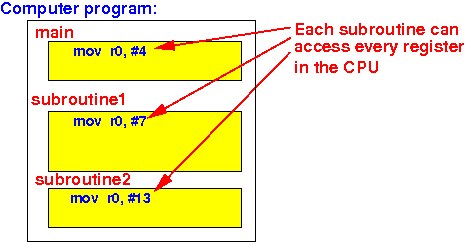Caveat: registers are shared among all functions (subroutines):
|
This has consequences on the value inside a register before and after a function call instruction
An important effect when you call a function shown with an example:
f1:
...
...
mov r0,#1 // Before function call to f2
...
bl f2
... // After function call to f2
...
add r1, r1, r0
|
Question: will the instruction add r1, r1, r0 always add 1 to register R1 ???
An important error explained with an example:
f1:
+----> f2: push {lr}
... | ...
... | ...
mov r0,#1 | mov r0, #9
... | ...
bl f2 ----------+ ...
... <--------------+ ...
... | ...
add r1, r1, r0 +------ pop {pc}
|
Answer: NO !!! --- After the function call bl f2, the register r0 can be overwritten !!!
Recall: an important rule in assembler programming:
|
|
